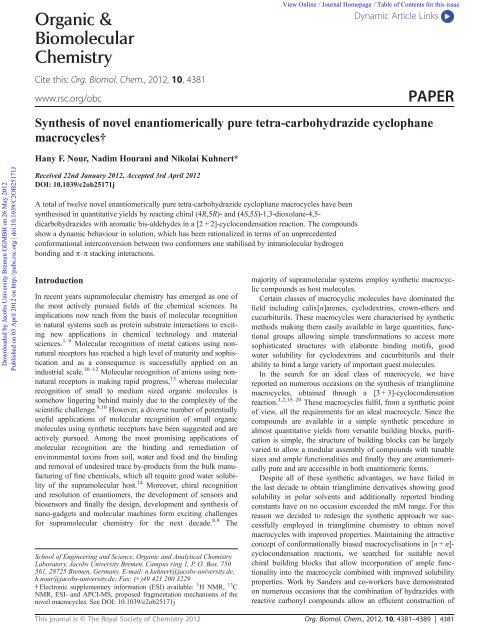The Development of Novel Antibiotics Using ... - Jacobs University
The Development of Novel Antibiotics Using ... - Jacobs University
The Development of Novel Antibiotics Using ... - Jacobs University
You also want an ePaper? Increase the reach of your titles
YUMPU automatically turns print PDFs into web optimized ePapers that Google loves.
Organic &<br />
Biomolecular<br />
Chemistry<br />
Cite this: Org. Biomol. Chem., 2012, 10, 4381<br />
www.rsc.org/obc<br />
View Online / Journal Homepage / Table <strong>of</strong> Contents for this issue<br />
Dynamic Article Links<br />
PAPER<br />
Synthesis <strong>of</strong> novel enantiomerically pure tetra-carbohydrazide cyclophane<br />
macrocycles†<br />
Hany F. Nour, Nadim Hourani and Nikolai Kuhnert*<br />
Downloaded by <strong>Jacobs</strong> <strong>University</strong> Bremen GGMBH on 26 May 2012<br />
Published on 03 April 2012 on http://pubs.rsc.org | doi:10.1039/C2OB25171J<br />
Received 22nd January 2012, Accepted 3rd April 2012<br />
DOI: 10.1039/c2ob25171j<br />
A total <strong>of</strong> twelve novel enantiomerically pure tetra-carbohydrazide cyclophane macrocycles have been<br />
synthesised in quantitative yields by reacting chiral (4R,5R)- and (4S,5S)-1,3-dioxolane-4,5-<br />
dicarbohydrazides with aromatic bis-aldehydes in a [2 + 2]-cyclocondensation reaction. <strong>The</strong> compounds<br />
show a dynamic behaviour in solution, which has been rationalized in terms <strong>of</strong> an unprecedented<br />
conformational interconversion between two conformers one stabilised by intramolecular hydrogen<br />
bonding and π–π stacking interactions.<br />
Introduction<br />
In recent years supramolecular chemistry has emerged as one <strong>of</strong><br />
the most actively pursued fields <strong>of</strong> the chemical sciences. Its<br />
implications now reach from the basis <strong>of</strong> molecular recognition<br />
in natural systems such as protein substrate interactions to exciting<br />
new applications in chemical technology and material<br />
sciences. 1–9 Molecular recognition <strong>of</strong> metal cations using nonnatural<br />
receptors has reached a high level <strong>of</strong> maturity and sophistication<br />
and as a consequence is successfully applied on an<br />
industrial scale. 10–12 Molecular recognition <strong>of</strong> anions using nonnatural<br />
receptors is making rapid progress, 13 whereas molecular<br />
recognition <strong>of</strong> small to medium sized organic molecules is<br />
somehow lingering behind mainly due to the complexity <strong>of</strong> the<br />
scientific challenge. 9,10 However, a diverse number <strong>of</strong> potentially<br />
useful applications <strong>of</strong> molecular recognition <strong>of</strong> small organic<br />
molecules using synthetic receptors have been suggested and are<br />
actively pursued. Among the most promising applications <strong>of</strong><br />
molecular recognition are the binding and remediation <strong>of</strong><br />
environmental toxins from soil, water and food and the binding<br />
and removal <strong>of</strong> undesired trace by-products from the bulk manufacturing<br />
<strong>of</strong> fine chemicals, which all require good water solubility<br />
<strong>of</strong> the supramolecular host. 14 Moreover, chiral recognition<br />
and resolution <strong>of</strong> enantiomers, the development <strong>of</strong> sensors and<br />
biosensors and finally the design, development and synthesis <strong>of</strong><br />
nano-gadgets and molecular machines form exciting challenges<br />
for supramolecular chemistry for the next decade. 8,9 <strong>The</strong><br />
School <strong>of</strong> Engineering and Science, Organic and Analytical Chemistry<br />
Laboratory, <strong>Jacobs</strong> <strong>University</strong> Bremen, Campus ring 1, P. O. Box. 750<br />
561, 28725 Bremen, Germany. E-mail: n.kuhnert@jacobs-university.de,<br />
h.nour@jacobs-university.de; Fax: (+)49 421 200 3229<br />
† Electronic supplementary information (ESI) available: 1 H NMR, 13 C<br />
NMR, ESI- and APCI-MS, proposed fragmentation mechanisms <strong>of</strong> the<br />
novel macrocycles. See DOI: 10.1039/c2ob25171j<br />
majority <strong>of</strong> supramolecular systems employ synthetic macrocyclic<br />
compounds as host molecules.<br />
Certain classes <strong>of</strong> macrocyclic molecules have dominated the<br />
field including calix[n]arenes, cyclodextrins, crown-ethers and<br />
cucurbiturils. <strong>The</strong>se macrocycles were characterised by synthetic<br />
methods making them easily available in large quantities, functional<br />
groups allowing simple transformations to access more<br />
sophisticated structures with elaborate binding motifs, good<br />
water solubility for cyclodextrins and cucurbiturils and their<br />
ability to bind a large variety <strong>of</strong> important guest molecules.<br />
In the search for an ideal class <strong>of</strong> macrocycle, we have<br />
reported on numerous occasions on the synthesis <strong>of</strong> trianglimine<br />
macrocycles, obtained through a [3 + 3]-cyclocondensation<br />
reaction. 1,2,15–20 <strong>The</strong>se macrocycles fulfil, from a synthetic point<br />
<strong>of</strong> view, all the requirements for an ideal macrocycle. Since the<br />
compounds are available in a simple synthetic procedure in<br />
almost quantitative yields from versatile building blocks, purification<br />
is simple, the structure <strong>of</strong> building blocks can be largely<br />
varied to allow a modular assembly <strong>of</strong> compounds with tunable<br />
sizes and ample functionalities and finally they are enantiomerically<br />
pure and are accessible in both enantiomeric forms.<br />
Despite all <strong>of</strong> these synthetic advantages, we have failed in<br />
the last decade to obtain trianglimine derivatives showing good<br />
solubility in polar solvents and additionally reported binding<br />
constants have on no occasion exceeded the mM range. For this<br />
reason we decided to redesign the synthetic approach we successfully<br />
employed in trianglimine chemistry to obtain novel<br />
macrocycles with improved properties. Maintaining the attractive<br />
concept <strong>of</strong> conformationally biased macrocyclisations in [n + n]-<br />
cyclocondensation reactions, we searched for suitable novel<br />
chiral building blocks that allow incorporation <strong>of</strong> ample functionality<br />
into the macrocycle combined with improved solubility<br />
properties. Work by Sanders and co-workers have demonstrated<br />
on numerous occasions that the combination <strong>of</strong> hydrazides with<br />
reactive carbonyl compounds allow an efficient construction <strong>of</strong><br />
This journal is © <strong>The</strong> Royal Society <strong>of</strong> Chemistry 2012 Org. Biomol. Chem., 2012, 10, 4381–4389 | 4381

















